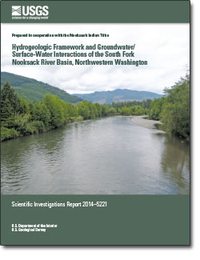Hydrogeologic framework and groundwater/surface-water interactions of the South Fork Nooksack River Basin, northwestern Washington
Links
- More information: USGS Index Page
- Document: Report (5.9 MB pdf)
- Plates:
- Download citation as: RIS | Dublin Core
Abstract
A hydrogeologic framework of the South Fork (SF) Nooksack River Basin in northwestern Washington was developed and hydrologic data were collected to characterize the groundwater-flow system and its interaction with surface‑water features. In addition to domestic, agricultural, and commercial uses of groundwater within the SF Nooksack River Basin, groundwater has the potential to provide ecological benefits by maintaining late-summer streamflows and buffering stream temperatures. Cold-water refugia, created and maintained in part by groundwater, have been identified by water-resource managers as key elements to restore the health and viability of threatened salmonids in the SF Nooksack River. The SF Nooksack River drains a 183-square mile area of the North Cascades and the Puget Lowland underlain by unconsolidated glacial and alluvial sediments deposited over older sedimentary, metamorphic, and igneous bedrock. The primary aquifer that interacts with the SF Nooksack River was mapped within unconsolidated glacial outwash and alluvial sediment. The lower extent of this unit is bounded by bedrock and fine-grained, poorly sorted unconsolidated glaciomarine and glaciolacustrine sediments. In places, these deposits overlie and confine an aquifer within older glacial sediments. The extent and thickness of the hydrogeologic units were assembled from mapped geologic units and lithostratigraphic logs of field-inventoried wells. Generalized groundwater-flow directions within the surficial aquifer were interpreted from groundwater levels measured in August 2012; and groundwater seepage gains and losses to the SF Nooksack River were calculated from synoptic streamflow measurements made in the SF Nooksack River and its tributaries in September 2012. A subset of the field-inventoried wells was measured at a monthly interval to determine seasonal fluctuations in groundwater levels during water year 2013. Taken together, these data provide the foundation for a future groundwater-flow model of the SF Nooksack River Basin that may be used to investigate the potential effects of future climate change, land use, and groundwater pumping on water resources in the study area. Site-specific hydrologic data, including time series of longitudinal temperature profiles measured with a fiber-optic distributed temperature sensor and continuous monitoring of stream stage and water levels measured in wells in adjacent wetlands and aquifers, also were measured to characterize the interaction among the SF Nooksack River, surficial aquifers, and riparian wetlands.
Study Area
| Publication type | Report |
|---|---|
| Publication Subtype | USGS Numbered Series |
| Title | Hydrogeologic framework and groundwater/surface-water interactions of the South Fork Nooksack River Basin, northwestern Washington |
| Series title | Scientific Investigations Report |
| Series number | 2014-5221 |
| DOI | 10.3133/sir20145221 |
| Year Published | 2014 |
| Language | English |
| Publisher | U.S. Geological Survey |
| Publisher location | Reston, VA |
| Contributing office(s) | Washington Water Science Center |
| Description | Report: vi, 36 p.; 2 Plates: 20.04 x 14.65 inches and 29.76 x 15 inches |
| Country | United States |
| State | Washington |
| Other Geospatial | South Fork Noooksack River |
| Online Only (Y/N) | Y |
| Additional Online Files (Y/N) | N |


